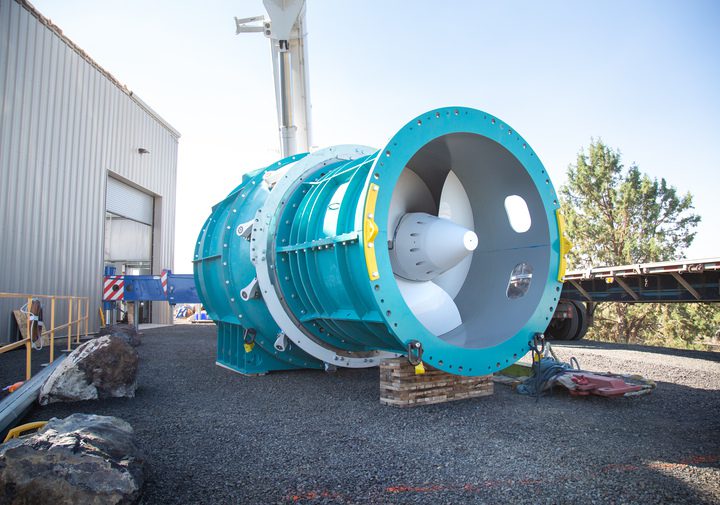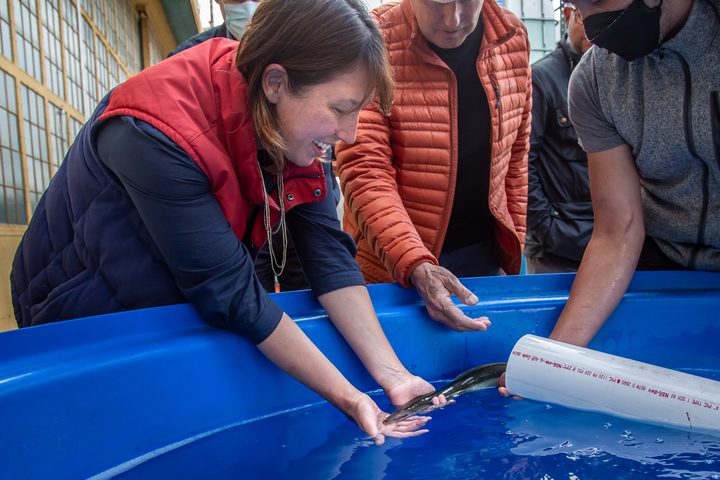Fish Friendly Hydro: Natel Energy Is Proving It’s Possible
Hydropower projects frequently face resistance from environmental groups for a variety of reasons. One of the more common objections to hydro is the high turbine-induced mortality of fish. The passage of fish through hydroelectric turbines can quickly prove fatal—a danger that increases with the size of the fish. Furthermore, if several hydropower plants are located in series on a river, which is often the case, this can lead to a total loss of certain species there.
One study, headed by the Leibniz Institute of Freshwater Ecology and Inland Fisheries (IGB), Germany’s largest and one of the leading international research centers for freshwaters, and funded by Germany’s Federal Agency for Nature Conservation (BfN) with funds from the Federal Ministry for the Environment, Nature Conservation and Nuclear Safety (BMU), suggests that small hydropower plants in particular are ecologically problematic. “The approximately 7,000 hydropower plants in Germany with an installed capacity of less than 1 MW produce only about 14% of the total electricity from hydropower of 17.5 TWh/year in 2019. Their contribution to a sustainable energy supply is thus marginal, but the damage they cause to freshwater ecosystems and fish stocks is comparatively high,” Dr. Christian Wolter, the IGB researcher who headed the study, said.
The German researchers suggested that a reduced risk of mortality at hydropower plants is only possible “if effective fish protection is installed.” They said mechanical fish deflectors, and adequately installed fish ladders and descent aids, the functionality of which must also be continuously checked and ensured, were required.
The Restoration Hydro Turbine (RHT)
However, Natel Energy, an Alameda, California–based hydro turbine developer and independent power producer, has shown that improving hydro turbine designs could be the ultimate answer to the problem. It has developed the Restoration Hydro Turbine (RHT, Figure 1), a compact hydroelectric turbine that couples high performance with safe through-turbine fish passage.

“Our thesis was that if we can make it safe for fish to move through hydropower facilities in a straightforward and easy way, then we can support reimagining hydropower overall, in a bit more of a distributed approach, but one where these projects actually also help to maintain passage and river connectivity,” Gia Schneider, co-founder and CEO of Natel Energy, said as a guest on The POWER Podcast. “Core to making that vision possible is a fish-safe turbine.”
The RHT is optimized for low head (from 2 meters to 20 meters) and doesn’t require fine fish screens. The design’s thick, slanted blades transport fish away from the leading edge into wide inter-blade regions and downstream to the outlet. The progressive slant of the blades from hub to tip also minimizes the likelihood of severe strike and eliminates the risk of entrapment between moving and stationary parts.
Schneider understands the challenges presented by multiple projects in a watershed or river. “If you’re in a watershed where you, say, have 10 projects down a river, then that means you need to be greater than 99% safe through each individual passage—each individual turbine—in order to achieve [an acceptable] population survival dynamic,” Schneider said. “And so, core for us is we want to achieve greater than 99% safe passage. We’ve kind of set that as an overall target. [It] doesn’t need to be quite that strict if you have fewer projects on a river, but it’s a good rule-of-thumb metric to aim for. And, then, we also want to be highly efficient, so up to 94% efficient from a power generation perspective.”
Testing Proves Fish Friendly Design
The results achieved during intense testing have been phenomenal. In a recently released, peer-reviewed paper, the findings from an eel passage study (Figure 2) were documented. “We’ve been able to actually show 100% passage of eel through our turbines, and with some pretty extreme conditions,” Schneider said. “We’re talking eel that are basically as long as the diameter of the turbine that they are going through—so fairly large eel relative to the size of the turbine—and where that turbine is spinning at 600, 700 rpm.”

Schneider said it’s really important to get that kind of data, because it helps substantiate the design with real results, showing it’s truly possible to design for high fish passage and high energy production at the same time. Natel has conducted several other studies, some with the Pacific Northwest National Laboratory (PNNL), with similarly impressive results.
Earlier this year, a Natel/PNNL test of 186 large rainbow trout—measuring up to 500 millimeters (19.7 inches) in length—found no meaningful difference between the fish passed through Natel’s 1.9-meter-diameter (roughly 6 feet) turbine and a control group, indicating that the RHT allows safe passage of some of the largest fish ever successfully passed through a compact hydro turbine. Earlier tests of smaller rainbow trout passed through Natel’s turbine demonstrated 100% survival.
Real-World Operations
Natel has three projects already in service—two in the U.S. and one in Europe—and all of them have been performing well. “We’ve been hitting greater than 97% availability across the three. Our project in Oregon this year basically ran itself for the water year and had 99.5% availability,” Schneider said.
“Those things matter, because at the end of the day, you want these assets to be able to run reliably,” she said. “We’re at the point where we’ve now got a bit of a track record that we can point to that shows we can build these turbines, we have all of our test results that show that they’re both fish safe and high power performance, and now we’ve got some field operating data from the first several projects installed that show that they are reliable and able to operate as normal power generation equipment.” The next step for Natel is scaling up.
To hear the full interview, which includes details about work Natel is doing in Africa in collaboration with MyHydro, opportunities Schneider sees to retrofit existing hydro units and add generation to non-powered dams, and more, listen to The POWER Podcast. Click on the SoundCloud player below to listen in your browser now or use the following links to reach the show page on your favorite podcast platform:
For more power podcasts, visit The POWER Podcast archives.
—Aaron Larson is POWER’s executive editor (@AaronL_Power, @POWERmagazine).